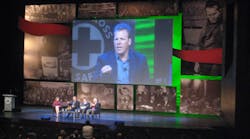The 2012 National Safety Council (NSC) Congress & Expo is in Mickey Mouse’s territory in Orlando, Fla., making it all the more appropriate for the event’s executive leadership forum to include safety expertise from Dan Cockerell, vice president of operations at Disney’s Hollywood Studios at Walt Disney Parks & Resorts. Among his tips? Empower employees, listen to their feedback, get in the trenches to understand real-life safety concerns, and demonstrate a visible commitment to safety.
With four theme parks, two water parks, more than 25 resort hotels, 66,000 employees and a daily population of 200,000, Walt Disney World faces some complex and unique safety challenges. At an NSC 2012 executive forum on Oct. 22, Cockerell acknowledged that leaders do not necessary control safety at Disney – rather, they influence it.
“We influence everything. We tell our leaders that 80 percent of the incidents at Disney World are caused by behaviors,” Cockerell said. “People need to own safety and own their behaviors.”
Disney recognizes three keys to safety: a commitment to a culture of safety; recognition that safety requires teamwork; and an understanding that safety goes beyond the workplace. Safety also is the first of Disney’s Four Keys (Safety, Courtesy, Show and Efficiency) and employees are required to practice safe behavior in all that they do; always put safety first; and speak up to ensure the safety of others.
That commitment to safety goes straight to the top. When Disney decided to take a harder look at its incidents and injuries, Meg Crofton, president of Walt Disney Parks and Resorts Operations, spoke with all Disney leaders about her own personal commitment to safety. She held 80 sessions over a 6-month period to speak to these leaders and not only share her own commitment to safety, but to offer open mic sessions to hear feedback from leaders.
The Show Must Go On – Safely
Disney has long stood by the old “The show must go on” adage. But now, the message is a little different: The show must go on – as long as it’s safe. Disney employees not only are empowered to stop work if something appears to be unsafe, but they are also rewarded or praised for doing so, even if it disrupts regular operations.
For example, an employee running a rollercoaster who observes something that could indicate a safety hazard is authorized to hit the emergency stop button – even if it displaces all guests from line and leads to an evacuation. If employees understand that company leadership will applaud them for taking the safe route, they will not be afraid to follow their instincts and thus ensure everyone’s safety.
Employees also will recognize a company’s genuine commitment to safety, Cockerell added, if they see leaders in the trenches taking an interest in their work and their safety. Get on the ground level to observe how things work and what could potentially cause a safety hazard, Cockerell advised.
“We need to take an interest in [employees’] work and the tools they use,” he said. “You have to listen to feedback, even if it’s difficult to hear. It’s up to us to dig and find out what’s going on,” he added. “Just use your eyes and think, ‘What here could get someone hurt?’ Look at it from a common-sense point of view.”
Once potential safety risks are identified, your job is not over. Now you have to address the issue – and it’s often more complex than simply shelling out some money for a fix. What is more challenging, he explained, is getting 66,000 employees to change their behaviors.
Sharing stories and helping employees understand that the company cares about them and their families can go a long way in influencing those behaviors. “You need to capture the hearts and minds of people,” Cockerell said. “With storytelling and sharing, you can get there.”

